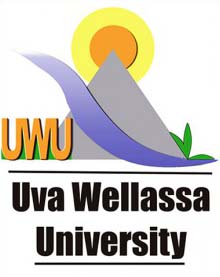Volume 04 Issue 01
01. Development of a Simple Non-toxic Scale Up Method to Extract Crude Collagen from Yellowfin Tuna (Thunnus albacares) Skin
Jayasundara J.M.S.S1, Egodauyana K.P.U.T4, Wimalarathne W2, Pitawala H.M.J.C3, Ekanayake R.M.T.C.B3 and Abeyrathne E.D.N.S1*
1 Department of Animal Science, Uva Wellassa University, Badulla 90000, Sri Lanka
2 Ceylon Fresh Seafood, Thudella road, Ja-Ela 11350, Sri Lanka
3 Department of Science and Technology, Uva Wellassa University, Badulla 90000, Sri Lanka
4 Key Laboratory of Tropical Marine Bio-resources and Ecology, South China Sea Institute of Oceanology, Chinese Academy of Science, Guangzhou, China
INFORMATION
Journal Title : Journal of Technology and Value Addition
Volume : 4 Issue : 1
Page : 01– 17
Correspondence : : sandun@uwu.ac.lk
ABSTRACT
The tuna processing industry generates significant amounts of fish waste with adverse environmental impacts. Therefore, it is important to identify potential ways to reduce waste, such as using waste for industrial-scale production. Thus, the aim of the present study was to develop a simple, innocuous, and scale-up method to extract crude collagen from yellowfin tuna (Thunnus albacares) skin. Collagen extraction was carried out through pre-treatment and soaking in acid to extract acid-soluble collagen. Collagen was extracted by acetic acid-soluble (0.4 M, 0.5 M, 0.6 M) and lactic acid-soluble (0.5 M, as control) methods. Sodium chloride (10% w/v) was used for the precipitation of crude collagen. For the agitation purpose, an especially prepared agitator was used. Then, 10% SDS-PAGE analysis and FTIR analysis were carried out to identify the extracted crude collagen. Collagen from 0.6M lactic acid-treated fish skin had the highest yield of 14.46 ± 0.56 % based on the skin’s wet weight (P < 0.05). All the crude collagen extracts of different concentrations exhibit Amide A, Amide B, Amide i, Amide ii, and Amide iii, which are the characteristic spectra of collagen in the FTIR spectrum (1700- 1600 cmˉ1). Based on the SDS-PAGE analysis, the crude collagen extracts have two α bands and one β band. Therefore, they are classified as type I collagen. Thus, this study revealed that tuna skin is an excellent source to extract collagen for commercial uses and the 0.6M lactic acid-treated method was the best method for extracting collagen from yellowfin tuna skin
Keywords: Acetic acid, extraction, fish collagen, lactic acid, tuna fish
2. Centella asiatica Essential Oil (CEO) Intercalated Montmorillonite Nanoclay; Development, Characterization, and Bioactivity Assessment
A.M. Wijethunga1*, N. Salim2, N.M. Adassooriya2
1 Department of Botany, Faculty of Applied Sciences, University of Sri Jayewardenepura, Gangodawila, Nugegoda, Sri Lanka
2 Department of Chemical & Process Engineering, Faculty of Engineering, University of Peradeniya, Peradeniya, Sri Lanka
INFORMATION
Journal Title : Journal of Technology and Value Addition
Volume : 4 Issue : 1
Page : 18– 36
Correspondence : anushiw@sci.sjp.ac.lk
ABSTRACT
Centella asiatica Essential Oil (CEO) is used in traditional ayurvedic medicine in China, India, and Sri Lanka. It has health benefits such as anticancer, antioxidant, antiulcer, and antimicrobial activities. But its low water solubility, low thermal, chemo and photostability, have limited its commercial applications. Intercalation of EO in nanomaterials is a feasible and successful solution to increase oil stability. Currently, there is no information available on the CEO nanoclay intercalation. Bright yellow coloured CEO was extracted using Clevenger apparatus. The oil yield was 0.04% (v/w), and the density was 830 kg m-3. Oil was subjected to GC-MS and identified 43 compounds including terpenes and chromenes accounting for 95.056% of the total. The most abundant compounds were α-humulene (23.74%), caryophyllene (18.64%), and β-farnesene (11.16%). Intercalated oil (MMT+CEO) was obtained by liquid assisted grinding. XRD results validated the successful CEO intercalation by detecting an increment of montmorillonite interlayer space from 11.9 Å to 14.2 Å. A comparison of FTIR spectra showed additional peaks after intercalation. The plate-like appearance of MMT was marginally interrupted in intercalation. The in vitro antioxidant activity of CEO was assessed by DPPH assay and obtained 508.6 ± 0.5 μg/ml as the IC50 value. α-humulene and Caryophyllene were identified as the major antioxidants. The IC50 value for the positive control; ascorbic acid, was 4.4 ± 2.3 μg/ml. According to the Kirby Bauer assay, a moderate antimicrobial activity was observed against Staphylococcus aureus. Low and negligible activities were demonstrated against Candida tropicalis and Escherichia coli. The minimum inhibitory concentration of CEO and MMT+CEO against S. aureus was 25 and 100 (µl/ml) respectively. The Colony counts of poison food technique decreased in MMT+CEO with time. Although in vitro antimicrobial activity doesn’t change qualitatively with intercalation, the quantitative activity was higher in non-intercalated form suggesting that nanoclay can act as a physical barrier.
Keywords: Antimicrobial activity, Centella asiatica, essential oil, montmorillonite, nano intercalation
3. Synthesis and Characterization of Lithium Montmorillonite Cathode Material for Li-ion Batteries
W.K.O.W Goonathilake*, P.W.S.K. Bandaranayake
Department of Physics, Faculty of Science, University of Peradeniya, Sri Lanka
INFORMATION
Journal Title : Journal of Technology and Value Addition
Volume : 4 Issue : 1
Page : 37– 52
Correspondence : kovidagoonathilake@gmail.com
ABSTRACT
A natural clay mineral, montmorillonite (MMT), is abundant in Sri Lanka in various areas such as Kandalama, Mawathagama, and Horana. In terms of the crystalline structure of MMT is classified as an aluminosilicate compound with a layered structure consisting of an octahedral aluminum-oxygen layer (Al-O) sandwiched between two tetrahedral layers of silicon-oxygen (Si-O). Different divalent and monovalent cations, such as Li+, H+, Mn2+, and Cu2+ can be inserted to interlayers of the MMT structure. In the present study, the natural montmorillonite has been modified and improved to use as a cathode material of Li-ion batteries. To enhance the ionic conductivity of MMT, the material was saturated with Li+ ions by using different concentrations of LiCl solutions. The electrical and structural properties of saturated Li-MMT were analyzed by using Complex Impedance Spectroscopy and Scanning Electron Microscope (SEM) respectively. The bulk conductivity of saturated Li-MMT was 7.47×10-6 S cm-1 at 30 C. Saturated Li-MMT has negligible electronic conductivity and the transference number is less than 0.002. To use as a cathode material in rechargeable Li ion batteries, an appreciable electronic conductivity (10-7 S cm-1) must also be present in the material. For that carbon black was added to the saturated Li-MMT. The DC polarization test was utilized to measure the electronic transference number of saturated Li-MMT with graphite electrodes. The electronic transference number of saturated Li-MMT with 20%, 25% and 30% carbon black was reported as 0.15, 0.16, and 0.17 respectively.
Keywords: Bulk conductivity, cation exchange, electronic transference number, lithium cathode, lithium montmorillonite.
4. Effects of Ammonium Laurate Concentration on Physico-mechanical Properties of Natural Rubber Latex
L.A.A. Dilmi 1*, A.P. Aththanayake2, G.A.A.R. Perera1 and E.A.L. Lochana1
1 Department of Export Agriculture, Faculty of Animal Science and Export Agriculture, Uva Wellassa University, Badulla, Sri Lanka
2 Department of Raw Rubber & Chemical Analysis, Rubber Research Institute, Rathmalana, Sri Lanka
INFORMATION
Journal Title : Journal of Technology and Value Addition
Volume : 4 Issue : 1
Page : 52 – 70
Correspondence : ayeshadilmi9704@gmail.com
ABSTRACT
Natural rubber latex tends to coagulate and putrefy shortly after harvesting. Therefore, ammonium laurate is added to stabilize natural rubber latex. However, excessive level of ammonium laurate may adversely affect physico-mechanical properties of natural rubber latex. This study was carried out to investigate the effects of ammonium laurate concentration on physico-mechanical properties of natural rubber latex with special reference to the glove formulation. Partially preserved, concentrated rubber latex samples were treated with varying amounts (0, 2, 4, and 8 ml) of 10% (w/v) ammonium laurate solution. Potassium hydroxide number, volatile fatty acid number and mechanical stability time of the samples were investigated weekly for a period of one month. After 21 days of maturation of latex samples, films were prepared and their tensile strength, elongation at break and tear strength were investigated. Ammonium laurate concentration significantly (P<0.05) affected on both mechanical stability time and volatile fatty acid number of latex during the storage time. The highest tensile strength and elongation at break were observed in the sample treated with 1.5×10-4 moles of ammonium laurate per 100 g of latex. Tear strength showed a positive linear relationship with the ammonium laurate concentration. It can be concluded that the ammonium laurate level of 1.63× 10⁻⁴ moles per 100 g of latex will enhance the physico-mechanical properties of natural rubber latex without negatively affecting its chemical properties such as VFA number and KOH number.
Keywords: Ammonium laurate, mechanical stability, potassium hydroxide number, volatile fatty acid, tensile strength
5.General Formulation of Nanoemulsions Using High-Energy and Low-Energy Principal Methods: A Brief Review
E.A.L. Lochana1* and P. A. S. Kawmudhi2
1 Department of Export Agriculture, Uva Wellassa University, Sri Lanka
2 Department of Science and Technology, Uva Wellassa University, Sri Lanka
INFORMATION
Journal Title : Journal of Technology and Value Addition
Volume : 4 Issue : 1
Page : 71 – 100
Correspondence : lakmini@uwu.ac.lk
ABSTRACT
Nanoemulsions represent the droplet size as 100 nm and defined as biphasic dispersion of two immiscible liquids. Nanoemulsions are thermodynamically unstable while kinetically stable and they are used in many industrial fields; such as food, medicinal, pharmaceutical, cosmetic, agricultural and chemical. Formation of nanoemulsions using mechanical devices with high energy input is referred as “High energy method” while the method that utilize internal chemical energy of components known as “Low energy method”. The High energy methods can be described in five sub-categories: the high-pressure homogenization method, microfluidizer method, ultrasonication method, jet disperser method and high shear stirring method. The low energy methods are self-nano emulsification, Phase inversion, D phase emulsification, Membrane emulsification, Microemulsion dilution, and Solvent displacement. Since low-energy approaches can develop nanoemulsions without high energy and without any expensive instruments, it can be considered a cost effective nanoemulsions formation method. But use of synthetic surfactants in low-energy method might limit their applications for food systems due to high requirement of surfactants for the stability of formed nanoemulsions with small sizes. In that case, high energy method is most effective even it consumes much energy. This review aims to highlight the high-energy and low energy nanoemulsions formation methods, major differences of those two methods and potential applications of nanoemulsions.
Keywords: Applications, high energy methods, low energy methods, Nanoemulsions


